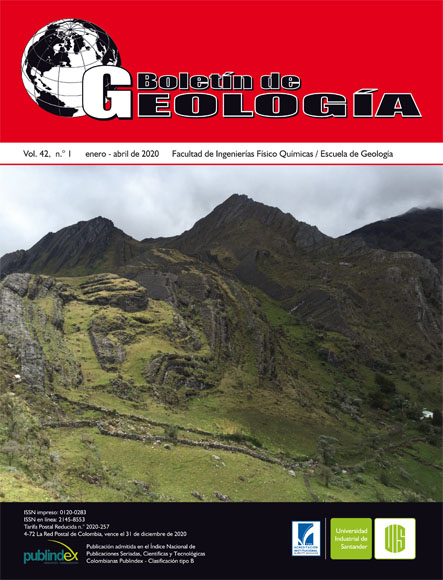Geochemical prospecting study in fluvial sediments of Chirimoyo and Guineo subbasins, Ecuador
Published 2020-01-22
Keywords
- Geochemical prospecting,
- stream sediments,
- Chirimoyo,
- Guineo,
- vanadium
- uranium ...More
How to Cite
Altmetrics

Abstract
A sampling of stream sediments was carried out in the Chirimoyo and Guineo microbasins, at the Puyango sector, Loja province, Ecuador, in order to perform a study of geochemical exploration, in which were determined anomalous values for CaO (>3.46wt%), MnO (>0.26wt%), P2O5 (>12.63wt%), V (>693 ppm), Zn (>709 ppm), Cu (>108 ppm) and, subanomalous values of U (>60 ppm) and, Ni (>232 ppm) for the subbasin Chirimoyo. As for the Guineo subbasin, the following anomalous values were determined: MnO (>0.47wt%), TiO2 (>1.16wt%), subanomalous values of CaO (>7.01wt%), P2O5 (>0,96wt%), V (>1903 ppm), U (>50 ppm), Ni (>451 ppm) and, Zn (>1306 ppm). According to the geochemical anomalies maps the highest values of vanadium (2520 ppm in Guineo), uranium (70 ppm in Chirimoyo), zinc (1445 ppm in Guineo) and nickel (629 ppm in Guineo) are associated with the northern part of both microbasins, specifically in the north of the Guineo microbasin close to the La Sota sector, where the sedimentary rocks of the Puyango Formation appear, which contain bituminous limestones and calcareous black shales, which may be hosting mineralizations of these elements, this is evidenced by the high values of Ca, which indicates a carbonate origin of the sediments. The sediments are composed mainly of silicates and aluminosilicates (clays and micas), in smaller proportion oxy-hydroxides of Fe-Ti: goethite, magnetite and anatase. Additionally, calcite and zircon were detected in two samples. There is the presence of vanadium minerals such as sherwoodite, rossite, ronneburgite and sincosite, which corroborates the vanadium geochemical anomalies determined by chemical analysis.
Downloads
References
Aspden, J.A., Bonilla, W., and Duque, P. (1995). The El Oro Metamorphic complex, Ecuador: geology and economic mineral deposits. British Geological Survey.
Bristow, C., y Hoffstetter, R. (1977). Léxico Estratigráfico Internacional. Volumen 5, Fascículo 5. Ecuador. París: Centre National de la Recherche Scientifique.
Bruneton, P., and Cuney, M. (2016). Geology of uranium deposits. In: I. Hore-Lacy (ed.). Uranium for Nuclear Power (pp. 11-52). London, United Kingdom: Elsevier.
Cumberland, S., Douglas, G., Grice, K., and Moreau, J. (2016). Uranium mobility in organic matter-rich sediments: A review of geological and geochemical processes. Earth Science Reviews, 159, 160-185. doi: 10.1016/j.earscirev.2016.05.010.
Cuney, M., and Kyser, T. K. (2008). Recent and not-so-recent developments in uranium deposits and implications for exploration. Quebec, Canada: Short Course Series v. 39.
Dill, H. (2010). The “chessboard” classification scheme of mineral deposits: Mineralogy and geology from aluminum to zirconium. Earth Science Reviews, 100(1-4), 1-420. doi: 10.1016/j.earscirev.2009.10.011.
Eguez, A., y Poma, O. (2001). La Cuenca Alamor-Lancones en el Contexto Geodinámico de los Andes de Huancabamba, SW Ecuador. Cuartas Jornadas en Ciencias de la Tierra, Escuela Politécnica Nacional, Quito, Ecuador.
Gao, J., Shen, B., and Liu, J. (2013). Distribution of Nickel and Vanadium in Venezuelan Crude Oil. Petroleum Science and Technology, 31(5), 509-515.
Ghandi, S., and Sarkar, B. (2016). Geochemical Exploration. In: S. Ghandi, B. Sarhar (eds.). Essentials of mineral exploration and evaluation (pp. 125-158). Amsterdam: Elsevier.
Hale, M., and Plant, J. (1994). Drainage Geochemistry. In: G. Govett. (ed.). Handbook of Exploration Geochemistry (pp. 3-761). Amsterdam: Elsevier.
Hawkes, H.E (1957). Principles of Geochemical Prospecting. USA: Geological Survey Bulletin 1000-F.
Huang, J., Huang, F., Evans, L., and Glasauer, S. (2015). Vanadium: Global (bio)geochemistry. Chemical Geology, 417, 68-89. doi: 10.1016/j.chemgeo.2015.09.019.
IAEA-NEA. (2016). Uranium 2016: Resources, Production and Demand Red Book. Nuclear Energy Agency Organization for Economic Co-operation and Development. International Agency Energy Atomic.
INIGEMM. (2013). Memoria Técnica, Hoja Geológica Puyango, Escala 1:50.000. Instituto Nacional de Investigación Geológico Minero Metalúrgico.
INIGEMM. (2017). Memoria Técnica Hoja Geológica Puyango, Escala 1:100000. Hoja 21, M VI-F. Quito, Ecuador. Instituto Nacional de Investigación Geológico Minero Metalúrgico.
Jaillard, E., Bengtson, P., Bulot, L., Dhont, A., Laubacher, G., and Robert, E. (1996). Stratigraphy of the western Celica Basin (SW Ecuador). III Symposium International sur la Géodynamique Andine. St. Malo, France.
Jaillard, E., Laubacher, G., Bengtson, P., Dhondt, A., and Bulot, L. (1999). Stratigraphy and evolution of the Cretaceous forearc Celica-Lancones basin of southwestern Ecuador. Journal of South American Earth Sciences, 12(1), 51-68. doi: 10.1016/S0895-9811(99)00006-1.
Kennerley, J. (1973). Geology of the Loja Province, Southern Ecuador. Institute of Geological Sciences Report 23.
Lecomte, A., Cathelineau, M., Deloule, E., Brouand, M., Peiffert, C., Loukola, K., Pohjolainen, E., and Lahtinen, H. (2014). Uraniferous bitumen nodules in the Talvivaara Ni–Zn–Cu–Co deposit (Finland): influence of metamorphism on uranium mineralization in black shales. Mineralium Deposita, 49(4), 513-533. doi: 10.1007/s00126-013-0502-3.
Lehmans, B. (2014). Metals in Black Shales. Acta Geologica Sinica (English Edition), 88(s2), 258-259. doi: 10.1111/1755-6724.12370_6.
Lewis, S., Henderson, R., Dickens, G., Shields, G., and Coxhell, S. (2010). The geochemistry of primary and weathered oil shale and coquina across the Julia Creek vanadium deposit (Queensland, Australia). Mineralium Deposita, 45(6), 599-620. doi: 10.1007/s00126-010-0287-6.
Pohl, W.L. (2011). Economic Geology Principles and Practice Metals, Minerals, Coal and Hydrocarbons – Introduction to Formation and Sustainable Exploitation of Mineral Deposits. Oxford: John Wiley & Sons Ltd.
Smith, K., and Huyck, H. (1999). An overview of the abundance, relative mobility, bioavailability, and human toxicity of metals. In: G. Plumlee, J. Logsdon (eds.). The Environmental Geochemistry of Mineral Deposits. Part A: Processes, Techniques, and Health Issues (pp. 29-70). Littleton, USA: Society of Economic Geologists, Inc.
Shoemaker, R. (1977). La geología y paleontología de los sedimentos cretácicos del valle del río Puyango, provincias de Loja y El Oro, Ecuador. Subcomisión Ecuatoriana PREDESUR – Towson State University - PREDESUR.Quito - Ecuador. Publicación N°64.
Thorbern, M. (1992). The chemical mobility and transport of elements in the weathering environment. In: C. Butt, H. Zeegers (eds.). Handbook of Exploration Geochemistry Volume 4 (pp. 79-96) Amsterdam, Holanda: Elsevier.
Villarreal, J., Levresse, G., Nieto, A., Alexandre, P., and Corona, R. (2016). Geochemistry and geochronology of the Sierra de Gomez Limestone-hosted U deposit, Chihuahua: Implications for distribution of Rio Grande rift mineral deposits in northern Mexico. Ore Geology Reviews, 76, 19-34. doi: 10.1016/j.oregeorev.2016.01.004.

